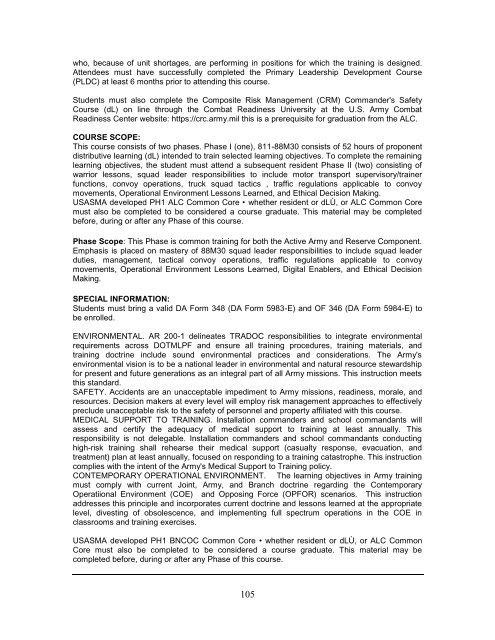FORWARD - Army Logistics University - U.S. Army
FORWARD - Army Logistics University - U.S. Army
FORWARD - Army Logistics University - U.S. Army
Create successful ePaper yourself
Turn your PDF publications into a flip-book with our unique Google optimized e-Paper software.
who, because of unit shortages, are performing in positions for which the training is designed.<br />
Attendees must have successfully completed the Primary Leadership Development Course<br />
(PLDC) at least 6 months prior to attending this course.<br />
Students must also complete the Composite Risk Management (CRM) Commander's Safety<br />
Course (dL) on line through the Combat Readiness <strong>University</strong> at the U.S. <strong>Army</strong> Combat<br />
Readiness Center website: https://crc.army.mil this is a prerequisite for graduation from the ALC.<br />
COURSE SCOPE:<br />
This course consists of two phases. Phase I (one), 811-88M30 consists of 52 hours of proponent<br />
distributive learning (dL) intended to train selected learning objectives. To complete the remaining<br />
learning objectives, the student must attend a subsequent resident Phase II (two) consisting of<br />
warrior lessons, squad leader responsibilities to include motor transport supervisory/trainer<br />
functions, convoy operations, truck squad tactics , traffic regulations applicable to convoy<br />
movements, Operational Environment Lessons Learned, and Ethical Decision Making.<br />
USASMA developed PH1 ALC Common Core whether resident or dLÙ, or ALC Common Core<br />
must also be completed to be considered a course graduate. This material may be completed<br />
before, during or after any Phase of this course.<br />
Phase Scope: This Phase is common training for both the Active <strong>Army</strong> and Reserve Component.<br />
Emphasis is placed on mastery of 88M30 squad leader responsibilities to include squad leader<br />
duties, management, tactical convoy operations, traffic regulations applicable to convoy<br />
movements, Operational Environment Lessons Learned, Digital Enablers, and Ethical Decision<br />
Making.<br />
SPECIAL INFORMATION:<br />
Students must bring a valid DA Form 348 (DA Form 5983-E) and OF 346 (DA Form 5984-E) to<br />
be enrolled.<br />
ENVIRONMENTAL. AR 200-1 delineates TRADOC responsibilities to integrate environmental<br />
requirements across DOTMLPF and ensure all training procedures, training materials, and<br />
training doctrine include sound environmental practices and considerations. The <strong>Army</strong>'s<br />
environmental vision is to be a national leader in environmental and natural resource stewardship<br />
for present and future generations as an integral part of all <strong>Army</strong> missions. This instruction meets<br />
this standard.<br />
SAFETY. Accidents are an unacceptable impediment to <strong>Army</strong> missions, readiness, morale, and<br />
resources. Decision makers at every level will employ risk management approaches to effectively<br />
preclude unacceptable risk to the safety of personnel and property affiliated with this course.<br />
MEDICAL SUPPORT TO TRAINING. Installation commanders and school commandants will<br />
assess and certify the adequacy of medical support to training at least annually. This<br />
responsibility is not delegable. Installation commanders and school commandants conducting<br />
high-risk training shall rehearse their medical support (casualty response, evacuation, and<br />
treatment) plan at least annually, focused on responding to a training catastrophe. This instruction<br />
complies with the intent of the <strong>Army</strong>'s Medical Support to Training policy.<br />
CONTEMPORARY OPERATIONAL ENVIRONMENT. The learning objectives in <strong>Army</strong> training<br />
must comply with current Joint, <strong>Army</strong>, and Branch doctrine regarding the Contemporary<br />
Operatiional Environment (COE) and Opposing Force (OPFOR) scenarios. This instruction<br />
addresses this principle and incorporates current doctrine and lessons learned at the appropriate<br />
level, divesting of obsolescence, and implementing full spectrum operations in the COE in<br />
classrooms and training exercises.<br />
USASMA developed PH1 BNCOC Common Core whether resident or dLÙ, or ALC Common<br />
Core must also be completed to be considered a course graduate. This material may be<br />
completed before, during or after any Phase of this course.<br />
105



